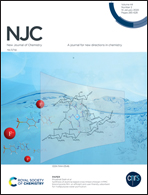Structure, stability and spectral properties of seleno[n]helicenes (n = 1–10)†
Abstract
The structure, energy and spectral properties of neutral end substituted seleno[n]helicenes (n = 1–10) are presented. Equilibrium structures are calculated by applying the B3LYP-D/6-311++G(d,p) method in DCM solvent considering a macroscopic solvent model. Single point energy calculations are also performed at the MP2 level to improve the energy parameters. The study reveals that non-planar structures are preferred for neutral seleno[n]helicenes, n = 3–10, and seleno[8]helicene has a helical structure with one complete turn. Excited state calculations are performed using Time-Dependent Density Functional Theory (TDDFT) to predict UV-visible spectra in DCM solvent. Calculations suggest that the dimerization of an end substituted neutral seleno[7]helicene system is not a favourable process; unsubstituted systems have a fair chance of dimerization though. Similar calculations are extended to radical cations of end substituted seleno[n]helicenes (n = 1–10). Similar to neutral selenohelicene systems, it is predicted that the radical cations of seleno[n]helicenes do prefer a non-planar structure leading to a helical structure for n ≥ 3. In the charged system also one turn of helicality gets completed in the case of the seleno[8]helicene radical cation. Excited state studies suggest that seleno[n]helicene radical cations have strong absorption in the far IR to near IR range. Energy parameters clearly indicate that the dimerization of even the radical cation of the end substituted seleno[7]helicene system is not a favorable process in DCM solvent. The presence of a PF6− counter ion in DCM solvent also does not have much effect on dimerization. Overall, this study explores the effect of charge, size and substitution on the molecular and electronic properties of seleno[n]helicenes in search of Se based suitable materials for applications as near infrared (NIR) electronic devices.
![Graphical abstract: Structure, stability and spectral properties of seleno[n]helicenes (n = 1–10)](/en/Image/Get?imageInfo.ImageType=GA&imageInfo.ImageIdentifier.ManuscriptID=C9NJ05001A&imageInfo.ImageIdentifier.Year=2020)


 Please wait while we load your content...
Please wait while we load your content...